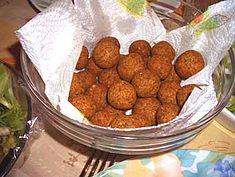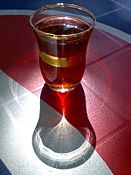Falafel balls
Emirati cuisine is a blend of many Middle Eastern and Asian cuisines.
The modern diet of the United Arab Emirates (UAE) is cosmopolitan, featuring dishes from around the world. A lot of people confuse Levantine food as being Emirati/Khaleej, but shawarma, hummous, tabbouleh,
and mixed grill, whilst having similar characteristics, are fairly
recent additions and do not do justice to the "soul food" that makes up
the Emirati menu..
Contents
Overview
Due to harsh desert conditions, the traditional food of the United Arab Emirates uses a lot of meat, grain, and dairy. Vegetables are easy to grow in some areas, and are strongly featured in the diet. Traditional dishes include Maq'louba, Margooga, Harees, Machbous, Frsee'ah, Fireed, Jisheid, and Mishwy. Meats traditionally used were chicken or small fowl, such as Houbara bustards, and goats. As camels are highly prized for their milk and transporting ability, the eating of camel meat is normally reserved for special occasions.
The dishes are usually like stews, as everything is often cooked in a single pot. Saffron, cardamom, turmeric, and thyme are the core flavors used in Emirati cookery. The introduction of rice
to the diet came when the traders moved to the region. Leaves from
indigenous trees, such as the Ghaff, were also used to stuff small
birds, releasing their flavor during the cooking process.
Breakfast in the UAE usually features breads like raqaq, khameer, and chebab, served with cheese, date syrup, or eggs. These were made over a curved hot plate, resembling a stone, which would have been used by the Bedouins. Balaleat is another dish, but its advent again with the traders, who introduced pasta.
Sweet options include luqeymat, a deep fried ball of pancake batter that is rolled in sesame seeds and then drizzled with date honey. Other desserts include khabeesa, which is flour bread crumbs blended with sugar, cardamom, and saffron or bethitha, a semolina blended with crushed dates, cardamom, and clarified butter.
At the close of the meal, it is usual to be served with a red tea infused with mint, which aids the digestion. Other traditions to the meal include a welcome with dates and gahwah (Arabic coffee), which are offered on arrival and are kept available through the guests visit.
Foods and dishes
Further information: Arab cuisine of the Persian Gulf
An example of lamb kebab sticks sold by a street vendor
Seafood
has been the mainstay of the Emirati diet for centuries. The United
Arab Emirates cuisine is a reflection of a great Arabian heritage and
vast exposure to civilizations over time. Muslims are prohibited from
eating pork, so it is not included in Arab menus. Meat, fish, and rice are the staple foods of the Emirati cuisine. Lamb and mutton are the more favored meats, then goat and beef.
Popular beverages are coffee and tea, which can be supplemented with cardamom, saffron, or mint to give it a distinct flavor.
Hotels frequently have pork substitutes such as beef sausages and
veal rashers on their breakfast menus. If pork is available, it is
clearly labelled as such.
Alcohol is generally only served in hotel restaurants and bars (but not in Sharjah).
All nightclubs and golf clubs are permitted to sell alcohol. Specific
supermarkets may sell pork, but are sold in separate sections.
Dishes forming part of the Emirati cuisine include:




Post a Comment